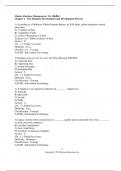Exam (elaborations)
Test Bank for Modern Database Management 13th Edition Heikki Topi, Jeffrey A Hoffer, Ramesh Venkataraman
Course
Modern Database Management 13th Edition
Institution
Modern Database Management 13th Edition
Test Bank for Modern Database Management 13th Edition Heikki Topi, Jeffrey A Hoffer, Ramesh Venkataraman
[Show more]
Preview 4 out of 373 pages
Uploaded on
April 16, 2024
Number of pages
373
Written in
2023/2024
Type
Exam (elaborations)
Contains
Questions & answers
Institution
Modern Database Management 13th Edition
Course
Modern Database Management 13th Edition
$17.99
100% satisfaction guarantee
Immediately available after payment
Both online and in PDF
No strings attached
1 Copyright © 2019 Pearson Education, Inc. Modern Database Management, 13e (Hoffer) Chapter 1 The Database Environment and Development Process 1) According to a McKinsey Global Institute Report, in 2010 alone, global enterprises stored more than: A) 1 terabyte of data. B) 3 gigabytes of data. C) at least 100 petabytes of data. D) more than 7 billion exabytes of data. Answer: D LO: 1.1: Define key terms. Difficulty: Easy Classification: Concept AACSB: Information Technology 2) Database management involves all of the following EXCEPT: A) coll ecting data. B) organizing data. C) design web pages. D) managing data. Answer: C LO: 1.1: Define key terms. Difficulty: Easy Classification: Concept AACSB: Information Technology 3) A database is an organized collection of ________ related data. A) logically B) physically C) loosely D) badly Answer: A LO: 1.1: Define key terms. Difficulty: Easy Classification: Concept AACSB: Information Technology 4) Legacy systems often contain data of ________ quality and are generally hosted on ________. A) poor; personal computers B) excellent; mainframes C) poor; mainframes D) excellent; workgroup computers Answer: C LO: 3.1: Define key terms. Difficulty: Moderate Classification: Concept AACSB: Information Technology NURSEDOCS 2 Copyright © 2019 Pearson Education, Inc. 5) Program -data dependence is c aused by: A) file descriptions being stored in each database application. B) data descriptions being stored on a server. C) data descriptions being written into programming code. D) data cohabiting with programs. Answer: A LO: 1.2: Name several limi tations of conventional file processing systems. Difficulty: Moderate Classification: Concept AACSB: Information Technology 6) Because applications are often developed independently in file processing systems: A) the data is always non -redundant. B) unplanned duplicate data files are the rule rather than the exception. C) data can always be shared with others. D) there is a large volume of file I/O. Answer: B LO: 1.2: Name several limitations of conventional file processing systems. Difficulty: Mode rate Classification: Concept AACSB: Information Technology 7) Relational databases establish the relationships between entities by means of common fields included in a file called a(n): A) entity. B) relationship. C) relation. D) association. Answer: C LO: 1.3: Explain at least 10 advantages of the database approach, compared to traditional file processing. Difficulty: Moderate Classification: Concept AACSB: Information Technology 8) A(n) ________ is often developed by identifying a form or report that a user needs on a regular basis. A) enterprise view B) reporting document C) user view D) user snapshot Answer: C LO: 1.3: Explain at least 10 advantages of the database approach, compared to traditional file processing. Difficulty: Moderate Classification: Concept AACSB: Information Technology NURSEDOCS 3 Copyright © 2019 Pearson Education, Inc. 9) A graphical system used to capture the nature and relationships among data is called a(n): A) XML data model. B) hypertext graphic. C) relational database. D) data model. Answer: D LO: 1.3: Exp lain at least 10 advantages of the database approach, compared to traditional file processing. Difficulty: Moderate Classification: Concept AACSB: Information Technology 10) Data that describe the properties of other data are: A) relationships. B) lo gical. C) physical. D) metadata. Answer: D LO: 1.3: Explain at least 10 advantages of the database approach, compared to traditional file processing. Difficulty: Moderate Classification: Concept AACSB: Information Technology 11) Metatdata typically describes all of the following EXCEPT: A) data definitions. B) length. C) allowable values. D) location on disk. Answer: D LO: 1.3: Explain at least 10 advantages of the database approach, compared to traditional file processing. Difficulty: Moder ate Classification: Concept AACSB: Information Technology NURSEDOCS 4 Copyright © 2019 Pearson Education, Inc. 12) A person, place, object, event, or concept about which the organization wishes to maintain data is called a(n): A) relationship. B) object. C) attribute. D) entity. Answer: D LO: 1.3: Expl ain at least 10 advantages of the database approach, compared to traditional file processing. Difficulty: Moderate Classification: Concept AACSB: Information Technology 13) ________ are established between entities in a well -structured database so that the desired information can be retrieved. A) Entities B) Relationships C) Lines D) Ties Answer: B LO: 1.3: Explain at least 10 advantages of the database approach, compared to traditional file processing. Difficulty: Moderate Classification: Concept AACSB: Information Technology 14) All of the following are primary purposes of a database management system (DBMS) EXCEPT: A) creating data. B) updating data. C) storing data. D) providing an integrated development environment. Answer: D LO: 1.3: Explain at least 10 advantages of the database approach, compared to traditional file processing. Difficulty: Difficult Classification: Concept AACSB: Information Technology NURSEDOCS




